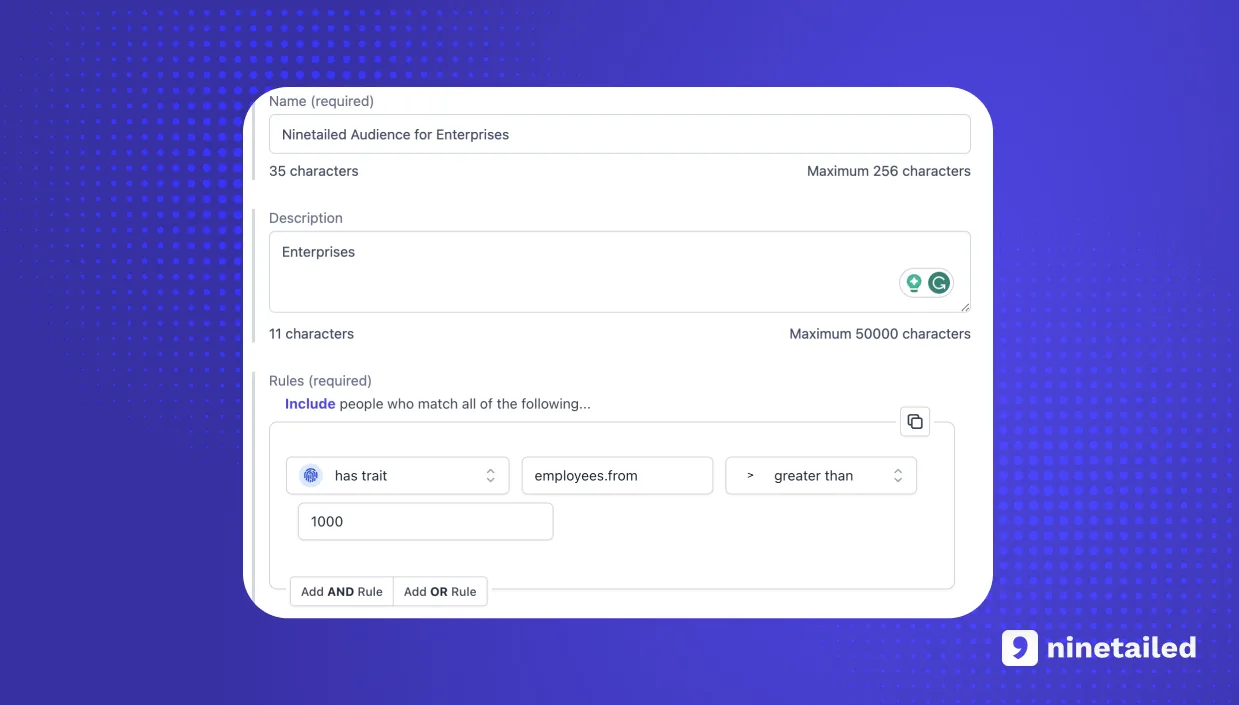- Growth,
- Segmentation
The Role of Firmographic Segmentation in Account-Based Marketing


As the B2B marketing landscape becomes increasingly competitive, businesses must employ innovative strategies to stay ahead and achieve targeted growth.
One such approach gaining considerable momentum is account-based marketing (ABM), a laser-focused tactic that hones in on high-value accounts with personalized marketing efforts.
Central to this methodology is the concept of firmographic segmentation, which involves classifying businesses based on shared characteristics such as industry, size, or location.
By harnessing the power of firmographic segmentation in ABM, marketers can unlock
higher ROI,
foster stronger customer relationships, and
ultimately drive business success.
In this blog post, we'll explore the intricacies of firmographic segmentation and examine its pivotal role in account-based marketing.
Benefits of Firmographic Segmentation in Account-Based Marketing
Enhanced Targeting and Personalization
One of the most notable benefits of incorporating firmographic segmentation in account-based marketing is the ability to enhance targeting and personalization significantly. By tailoring marketing efforts to specific industries or company sizes and personalizing content to resonate with target accounts, businesses can create more meaningful connections and drive better results.
Firmographic segmentation allows marketers to identify and group similar businesses based on shared characteristics such as industry, company size, revenue, location, and organizational structure. This categorization enables marketers to develop a deeper understanding of their target accounts' unique needs, challenges, and opportunities.
Armed with this knowledge, businesses can then tailor their marketing strategies and campaigns to address the specific pain points and requirements of each segment.
For instance, a software company could create customized marketing materials for small businesses and large enterprises, highlighting the features and benefits that are most relevant to each group. This level of customization ensures that the marketing message aligns with the target audience's interests and needs, making it more likely to capture their attention and prompt action.
Moreover, personalizing content to resonate with target accounts further strengthens the connection between the brand and its audience. By crafting content that speaks directly to the needs and preferences of each account, businesses can demonstrate their understanding of the account's unique challenges and showcase their expertise in providing tailored solutions. This not only helps establish trust and credibility but also fosters long-lasting relationships, ultimately leading to increased customer loyalty and higher conversion rates.
Improved Sales Alignment, Increased Efficiency, and Higher ROI
One significant advantage of incorporating firmographic segmentation in account-based marketing is the potential for improved sales alignment. By focusing on high-value accounts and aligning marketing and sales efforts, businesses can drive better results and optimize their resources for maximum impact.
Firmographic segmentation plays a crucial role in identifying and prioritizing high-value accounts based on factors such as industry, company size, revenue, and growth potential. This targeted approach allows both marketing and sales teams to concentrate their efforts on accounts that are most likely to yield substantial returns, ensuring that resources are allocated efficiently and effectively.
With a clear understanding of the target accounts, marketing and sales teams can work together more cohesively to develop and execute customized strategies tailored to each account's unique needs and challenges. This collaborative approach ensures that marketing campaigns are designed to generate high-quality leads while sales teams are equipped with the insights and information necessary to nurture and close deals.
Improved sales alignment also facilitates better communication and coordination between marketing and sales departments. By establishing common goals and sharing insights about target accounts, both teams can gain a deeper understanding of the customer journey and the most effective ways to engage prospects at each stage. This unified approach enables teams to make data-driven decisions, adjust strategies in real-time, and ultimately drive higher conversion rates and revenue.
How to Implement Firmographic Segmentation in Your ABM Strategy
1. Identify Your Ideal Customer Profile (ICP)
Analyzing Your Best Customers
Start by examining your current customer base, particularly those who have generated the highest revenue and exhibited long-term loyalty. Analyze their firmographic characteristics to identify patterns and trends that can inform your ICP.
Defining Key Characteristics of Your ICP
Based on your analysis, define the specific firmographic traits that constitute your ideal customer profile. These might include industry, company size, location, revenue, and growth potential.
2. Gather Firmographic Data
Various Sources for Obtaining Firmographic Information
Collect firmographic data on your target accounts from multiple sources such as public records, business directories, social media, industry reports, and third-party data providers.
Ensuring Data Quality and Accuracy
Verify the accuracy of the collected data and ensure it is up-to-date. Inaccurate or outdated information can hinder the effectiveness of your ABM strategy.
3. Segment Your Target Accounts
Grouping Accounts Based on Shared Firmographic Traits
Categorize your target accounts into distinct segments based on their firmographic characteristics. This enables you to create highly targeted and personalized marketing campaigns for each group.
Creating Tailored Marketing Campaigns for Each Segment
Develop customized marketing strategies and content that address the unique needs, challenges, and opportunities of each segment. This ensures that your campaigns resonate with your target audience and drive better results.
4. Measure and Optimize
Tracking the Success of Your ABM Efforts
Monitor the performance of your ABM campaigns by using key performance indicators (KPIs) such as conversion rates, deal size, and customer lifetime value. This helps you assess the effectiveness of your firmographic segmentation and fine-tune your approach as needed.
Continuously Refining Your Firmographic Segments and Campaigns
Based on the insights gathered from your performance metrics, make data-driven adjustments to your firmographic segments and marketing campaigns. Continuously refining your ABM strategy ensures that it remains relevant, effective, and aligned with your business goals.
Real-Life Examples of Firmographic Segmentation in ABM
Successfully Target Specific Industries
Firmographic segmentation plays a crucial role in account-based marketing by allowing businesses to target specific industries effectively.
By understanding the unique needs and challenges faced by companies within a particular industry, marketers can create tailored campaigns that resonate with their target audience and drive better results.
Here is an example of how a SaaS company can successfully leverage firmographic segmentation to target the apparel and fashion industry through ABM:

A software-as-a-service (SaaS) company that specializes in apparel and fashion e-commerce solutions recognizes the potential for growth within the booming e-commerce industry.
Using firmographic segmentation, the company identifies e-commerce businesses as its primary target audience and crafts a customized ABM campaign that addresses the unique challenges these businesses face, such as inventory management, customer data security, and seamless integration with existing systems.
By targeting e-commerce businesses and developing tailored content that highlights the SaaS company's expertise in addressing industry-specific pain points, the company effectively captures the attention of its target audience and generates high-quality leads, ultimately driving increased revenue.
Increase ROI by Focusing On a Particular Company Size
Focusing on a particular company size can significantly increase the ROI of your marketing efforts.
By narrowing down your target audience, you can create more tailored and relevant messages, leading to more meaningful engagements with potential clients.
Let's explore an example of how a SaaS business can use firmographic segmentation to focus on a specific company size and achieve success with its ABM strategies:

A SaaS software provider specializing in customer relationship management (CRM) solutions discovered that their product was well-suited for enterprise users.
They can decide to focus their ABM efforts on this segment, creating tailored content and offers that address the specific challenges faced by SMBs.
This can allow them to differentiate themselves from competitors targeting small businesses and result in higher conversion rates and increased ROI.
The Bottom Line
In conclusion, firmographic segmentation plays a crucial role in the success of account-based marketing campaigns.
By categorizing target accounts based on factors such as industry, company size, location, and other relevant characteristics, marketers can develop highly tailored strategies that resonate with their audience and address specific pain points.
This targeted approach enables businesses to allocate their resources more efficiently, improve engagement, and ultimately increase ROI.
Learn how to deliver unique and personalized customer experiences to increase conversions
Frequently Asked Questions About Firmographic Segmentation and Account-Based Marketing
How Is Firmographic Data Important to Account-Based Marketing (ABM)?
Firmographic data is critical to account-based marketing (ABM) efforts. This data provides key information about a company, including size, industry, location, and more. This information can be used to segment and target accounts and personalize messages and content.
In order for ABM to be successful, marketers need to have a deep understanding of their target accounts. Firmographic data can help with this by providing insights into the type of companies that are likely to be good fits for their products or services. For example, a marketer selling enterprise software would want to target firms with over 500 employees.
Additionally, firmographics can be used to create targeted content. If a marketer knows that their target account is in the financial services industry, they can create content that speaks directly to the challenges and needs of that industry.
Finally, firmographic data can be used to measure account engagement. By tracking how accounts interact with your marketing materials (e.g., website visits, downloads, etc.), you can better understand which accounts are most interested in your products or services. This information can then be used to prioritize outreach efforts.
In summary, firmographic data is essential to successful ABM campaigns. This data provides valuable insights into target accounts and helps marketers create more personalized and relevant content. Additionally, firmographics can be used to measure account engagement and prioritize outreach efforts.
What Are the Best Practices for Creating an Effective Account-Based Marketing Strategy Using Firmographic Data?
Here is a 10-step checklist for creating an effective account-based marketing strategy using firmographics:
Define Clear Objectives: Establish clear goals for your account-based marketing (ABM) campaign, such as increasing revenue, building brand awareness, or improving customer retention.
Identify Target Accounts: Use firmographic data to identify high-value accounts that align with your business goals and have the greatest potential for growth. Factors to consider may include company size, industry, location, and annual revenue.
Create a Comprehensive Account Profile: Develop a detailed profile for each target account, including information about their business model, organizational structure, key decision-makers, pain points, and potential needs.
Personalize Your Messaging: Craft tailored messages and content for each target account, addressing their unique needs and challenges. Personalized communication can help build stronger relationships and demonstrate your understanding of their business.
Choose the Right Channels: Determine the most effective communication channels for reaching your target accounts, whether it's email, social media, phone calls, or in-person events. Focus your efforts on the channels that yield the best results.
Coordinate Across Teams: Ensure alignment between sales, marketing, and customer success teams to provide a consistent experience for your target accounts. Collaboration and communication are key to executing a successful ABM strategy.
Leverage Technology: Utilize tools and platforms that help gather, analyze, and manage firmographic data, as well as automate and streamline your ABM processes. Examples include CRM systems, marketing automation platforms, and analytics tools.
Monitor and Measure Success: Establish key performance indicators (KPIs) to track the success of your ABM campaigns, such as engagement metrics, conversion rates, and revenue generated. Analyze the data regularly and adjust your strategy as needed to optimize results.
Continuously Refine Your Approach: As you gather more data and insights, refine your target account selection criteria, messaging, and overall strategy. Continuous improvement will help you stay ahead of the competition and maximize the ROI of your ABM efforts.
Invest in Ongoing Education: Stay informed about the latest trends and best practices in firmographic segmentation and account-based marketing. Encourage your team to participate in industry events, webinars, and training sessions to enhance their skills and knowledge.
How Can Businesses Identify the Right Accounts to Target in Their ABM Campaigns Using Firmographics?
Businesses can identify the right accounts to target in their ABM campaigns using firmographics by following these steps:
Define Your Ideal Customer Profile (ICP): Start by outlining the characteristics of your ideal customer, considering factors such as company size, industry, location, annual revenue, and growth potential. Your ICP will serve as a benchmark for selecting target accounts.
Gather Firmographic Data: Collect data on potential target accounts from various sources, including public records, industry reports, company websites, social media profiles, and third-party data providers. This information will help you assess the suitability of each account.
Segment the Market: Categorize potential target accounts based on the firmographic criteria defined in your ICP. This segmentation will enable you to identify accounts with similar characteristics and needs, allowing for more focused and personalized marketing efforts.
Prioritize Accounts: Evaluate the potential value of each account within your segments, considering factors such as revenue potential, strategic fit, and likelihood of conversion. Prioritize high-value accounts that align with your business goals and have a higher probability of success.
Research Decision-Makers: Identify key decision-makers within your target accounts, such as executives, department heads, or influential stakeholders. Understanding their roles, responsibilities, and pain points will help you tailor your messaging and approach.
Analyze Engagement Data: Review historical engagement data with potential target accounts, such as previous interactions, sales history, and marketing response rates. High levels of engagement may indicate a strong interest in your products or services and can help you further prioritize your target list.
Refine Your Target List: Continuously update and refine your target account list based on new insights, changing market conditions, or shifts in your business strategy. Regularly reassessing your target accounts ensures that your ABM efforts remain focused and effective.
Leverage Technology: Utilize CRM systems, marketing automation platforms, and analytics tools to manage and analyze firmographic data, track engagement, and monitor the success of your ABM campaigns. These technologies can streamline your processes and help you make data-driven decisions.
Are There Any Potential Challenges or Pitfalls When Implementing Firmographic Segmentation and ABM Strategies?
Yes, there are potential challenges and pitfalls when implementing firmographic segmentation and ABM strategies. Some of these include:
Incomplete or Inaccurate data: The effectiveness of firmographic segmentation and ABM depends on the quality of your data. Inaccurate or outdated information can lead to targeting the wrong accounts, wasting resources, and negatively impacting campaign performance.
Limited Account Selection: Overemphasis on specific firmographic criteria may limit your pool of target accounts, causing you to miss out on potentially valuable opportunities. It's essential to strike a balance between focusing on high-value accounts and maintaining a diverse target list.
Lack of Personalization: Generic messaging and content can hinder the success of ABM campaigns. Failing to personalize your approach for each target account may result in low engagement rates and reduced effectiveness.
Inadequate Alignment Between Teams: Poor collaboration and communication between marketing, sales, and customer success teams can lead to inconsistent messaging, missed opportunities, and overall inefficiency in executing ABM strategies.
Insufficient Resources: Implementing an effective ABM strategy requires dedicated resources, including time, budget, and personnel. Underestimating the investment needed to execute ABM successfully can lead to suboptimal results.
Overlooking the Customer Journey: Focusing solely on acquiring new accounts can cause businesses to neglect existing customers. It's essential to consider the entire customer journey, from acquisition to retention and growth, when implementing ABM strategies.
Measuring Success: Identifying the right KPIs and measuring the success of your ABM campaigns can be challenging. Inaccurate or incomplete performance tracking can make it difficult to optimize your strategies and demonstrate ROI.
Adapting to Change: Market conditions, customer needs, and business priorities can change rapidly. Failing to adapt your firmographic segmentation and ABM strategies in response to these changes can lead to missed opportunities and reduced effectiveness.
To overcome these challenges, businesses should invest in data quality, personalization, team alignment, and continuous improvement. Regularly reviewing and refining your firmographic segmentation and ABM strategies can help you stay agile and maximize the return on your marketing efforts.
Learn how to deliver unique and personalized customer experiences to increase conversions

